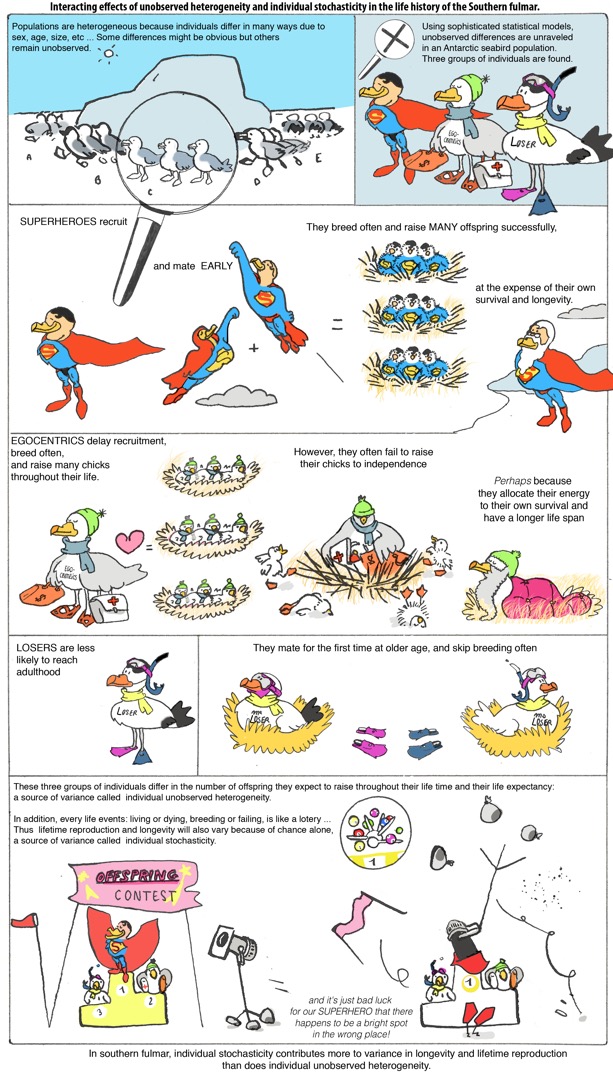Seabirds responses to global change
Different population responses to global change
Winners and Losers? Not all species respond the same way.
Seabirds are excellent indicators of environmental change, but their responses are far from uniform. Different species—and even different individuals within a species—respond in distinct ways, depending on their life history strategies and habitat use.
For example, emperor penguins and snow petrels both rely on sea ice, but with contrasting consequences. Emperor penguins breed annually and their adult survival declines in years with low sea ice. Snow petrels, on the other hand, often skip breeding in poor years—protecting their survival and future reproductive potential (Jenouvrier et al. 2005).
Habitat use also plays a key role. Emperor penguins require fast ice (sea ice attached to the coastline) for breeding during winter and nearby polynyas (ice-free openings) for feeding. In contrast, Adélie penguins nest on ice-free land during summer and depend on divergent pack ice for access to prey (Ainley et al. 2010). These differences mean that the same environmental shift can have very different demographic consequences across species.
To better understand how seabirds will respond to future environmental change, we compare species with:
- Contrasting life history strategies (e.g., snow petrels vs. penguins), and
- Distinct habitat requirements (e.g., Adélie vs. emperor penguins).
But the story doesn’t end there.
Individuals respond differently to global change
Variation exists not just between species, but within populations (Van de Walle et al. 2023). Individuals differ in traits such as size, timing of breeding, personality, and lifespan. Some are bold, others shy. Some breed early and often; others delay or reproduce infrequently. Most raise few offspring—but a rare few produce many.
These differences shape how individuals experience and respond to environmental change. For example, some individuals adjust their foraging behavior or phenology more flexibly than others. Such variation in behavioral, physiological, and demographic traits (e.g., survival, fecundity) can influence population-level resilience in complex ways (Jenouvrier et al. 2018a JAE).
One example of how individual behavior shapes demography lies in the formation and breakdown of pair bonds. In long-lived seabirds like the wandering albatross and snow petrel, stable, lifelong partnerships are typically essential for successful reproduction. Our research has shown that in wandering albatrosses, some males—particularly shy individuals—are more likely to be “divorced” by their partners, especially in populations where males outnumber females (Sun et al. 2022a Biology Letters). These breakups can lower breeding success, reduce the total number of offspring raised over a lifetime, and even shorten life expectancy (Sun et al. 2022b Ecological monographs). Environmental changes can also disrupt pair bonds. In snow petrels, for instance, the likelihood of divorce increases during years with difficult foraging conditions, such as those caused by reduced sea ice (Sun et al. 2024). These findings show how personality traits and environmental pressures can interact, with subtle individual differences ultimately influencing the dynamics of entire populations.
Moreover, even among individuals that appear identical in observable traits, outcomes like lifespan or total offspring vary due to chance alone—a phenomenon known as individual stochasticity. This randomness is a fundamental feature of biology and contributes to the natural variability we observe in populations (Jenouvrier et al. 2018b JAE, Jenouvrier et al. 2022).
Our goal is to understand how environmental change affects populations by examining both functional traits and demographic responses, across species and individuals. Only by embracing this complexity can we improve predictions—and ultimately conservation strategies—for species in a changing world
Current and Past Grants Supporting Research on Individual Variation and Population Dynamics
- NSF: The Demography and Dynamics of Heterogeneous Populations
- NSF: Linking Foraging Behaviors to Demography to Understand Albatrosses Population Responses to Climate Change
- WHOI -Independant Study Award: Life Histories Consequences of Individual Differences in Behavior for Seabirds
- NSFGEO-NERC: Integrating Individual Personality Differences in the Evolutionary Ecology of a Seabird in the Rapidly Changing Polar Environment
Outreach
Multimedia
Oceanus
- From Penguins to Polar Bears
The impacts of climate change in polar regions - Seabirds Face Risks from Climate Change
Scientists who study birds in remote regions also confront danger

